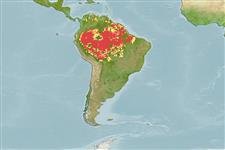Classification / Names
Common names from other countries
Main reference
Lima, F.C.T., L.R. Malabarba, P.A. Buckup, J.F. Pezzi da Silva, R.P. Vari, A. Harold, R. Benine, O.T. Oyakawa, C.S. Pavanelli, N.A. Menezes, C.A.S. Lucena, M.C.S.L. Malabarba, Z.M.S. Lucena, R.E. Reis, F. Langeani, C. Moreira et al. …. 2003. (Ref. 38376)
References |
Biblio |
Coordinator |
Collaborators
Size / Weight / Age
Max length : 23.8 cm SL male/unsexed; (Ref. 111115); common length : 14.0 cm TL male/unsexed; (Ref. 10612); common length :18 cm TL (female); max. published weight: 211.00 g (Ref. 111115)
Length at first maturity
Lm ?, range 15 - 16 cm
Environment
Freshwater; benthopelagic; pH range: 5.0 - 9.0; potamodromous (Ref. 51243); depth range 0 - 5 m (Ref. 10615)
Climate / Range
Tropical; 22°C - 30°C (Ref. 9110), preferred ?; 1°N - 8°S
Distribution
IUCN Red List Status (Ref. 115185)
Threat to humans
Harmless
Human uses
Fisheries: subsistence fisheries; bait: occasionally
More information
ReferencesAquacultureAquaculture profileStrainsGeneticsAllele frequenciesHeritabilityDiseasesProcessingMass conversion
Tools
Special reports
Download XML
Internet sources
Estimates of some properties based on models
Phylogenetic diversity index
PD50 = 0.5000 many relatives (e.g. carps) 0.5 - 2.0 few relatives (e.g. lungfishes)
Trophic Level
2.7 ±0.30 se; Based on food items.
Resilience
Vulnerability
Low vulnerability (19 of 100)
Price category
